

HelloSiam.com welcomes you to Bangkok- The city of Angels.
Bangkok which is locally called "Krung Thep" which means the City of Angels established in 1782 by King Rama I as the capital of Siam at that time and has been the capital of Thailand since then. Bangkok has retained its traditional charm with a mixture of old cultural heritage and new modern skyscrapers, luxurious hotels, shopping centers, street shopping, famous Thai food, restaurants, sports, entertainment.
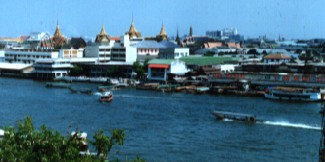 Located on the banks of the Chao Phraya River, a few kilometers upstream from its outflow into the Gulf of Siam, Bangkok sprawls across a flat alluvial plain. It is the capital in every sense of the word. It is where the Royal family resides, it is the seat of government and administration, and it is the focal point for virtually all major industrial, commercial and financial activity. It is
Located on the banks of the Chao Phraya River, a few kilometers upstream from its outflow into the Gulf of Siam, Bangkok sprawls across a flat alluvial plain. It is the capital in every sense of the word. It is where the Royal family resides, it is the seat of government and administration, and it is the focal point for virtually all major industrial, commercial and financial activity. It is
the country's main port and home to one tenth of the Kingdom's population.
Such an all-important role is reflected in the capital's proper name, Krung Thep. This translates as "City of Angel" and is the first in a whole string of illustrious titles that properly define the place and, incidentally, earn a listing in the Guinness Book of Records as the world's longest place name.
The real and full name of BANGKOK is:
"Krung Thep Mahanakhon Bovorn Ratanskosin Magintharayutthaya Mahadilokpop Noparatratchathani Burirom Udomratchanivetmahasathan Avatartsathit Sakkathattiya Visnukarmrasit"
Translated in English it means "City of Angels, greatest of all cities, home of the emerald Buddha, immortal, precious jewel, invincible stronghold, ancient and honorable, crowned with nine jewels, heavenly city, founded by Indra and rebuilt by Vishnu"
To the Thais Bangkok is always Krung Thep, the spiritual and symbolic as well as physical heart of the nation.
Bangkok is a fascinating mix of chaos and tranquility. Few people like the city at first sight - it seems too large, too noisy, too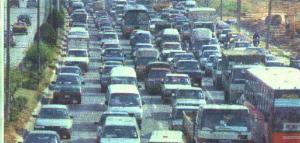 congested, and too crowded with people, buildings, and vehicles of all kind.
However you will find here - very often where you would least expect it - among all the noise and traffic quiet and shadowy temple courtyards, peaceful alleys, lined by old
teakwood houses, where time seems to have stood still, and the golden towers and Buddha statues of the city's splendid temples and palaces.
congested, and too crowded with people, buildings, and vehicles of all kind.
However you will find here - very often where you would least expect it - among all the noise and traffic quiet and shadowy temple courtyards, peaceful alleys, lined by old
teakwood houses, where time seems to have stood still, and the golden towers and Buddha statues of the city's splendid temples and palaces.
On your first ride from the airport into town you will not believe your eyes -
you would see ugly concrete blocks, polluted air, and cars wherever you
turn. You will start wondering where is the fascinating tropical wonderland with overwhelming scenery and lovely golden and
jeweled temples that you were told to expect? Don't give up too soon! The "City of Angels" has
many different faces, the beautiful architecture and cultural monuments are there - but you must actively seek them
out. Krung Thep does not parade its charms to the visitor - you must discover them on your own.
In the midst of dynamic modern growth, Bangkok miraculously manages to preserve its cultural heritage to a marked degree. The soaring roofs and gleaming spires of the Grand Palace and the city’s many historic temples – Temple of the Emerald Buddha, Temple of Dawn and other evocative shrines – present the visitor with a picture of medieval Oriental wonder; the very stuff of Eastern fairytales. And contained within Bangkok’s monuments and sights are treasures of the nation’s artistic and cultural endeavor that illustrate the land and the people.
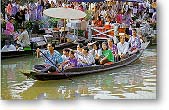 The influence of the past and the enduring threads
of the social fabric are not limited to the static. They continue to pervade
daily life. Files of saffron-robed monks making their early morning alms round,
for example, present an image unaltered in essentials by the passing of time.
Today’s backdrop of high-rise buildings serve only to emphasize the exotic and
timeless scene, while the city draws definition from it. Indeed,
there is much to discover, and in addition to the city’s most famous monuments
there are numerous lesser known sights of great interest. The Chapel of the
Emerald Buddha, which enshrines the national palladium, rightly tops the
sightseeing list, but Bangkok numbers more than 400 temples, many of which have
their own fascination.
The influence of the past and the enduring threads
of the social fabric are not limited to the static. They continue to pervade
daily life. Files of saffron-robed monks making their early morning alms round,
for example, present an image unaltered in essentials by the passing of time.
Today’s backdrop of high-rise buildings serve only to emphasize the exotic and
timeless scene, while the city draws definition from it. Indeed,
there is much to discover, and in addition to the city’s most famous monuments
there are numerous lesser known sights of great interest. The Chapel of the
Emerald Buddha, which enshrines the national palladium, rightly tops the
sightseeing list, but Bangkok numbers more than 400 temples, many of which have
their own fascination.
A similar selection can be made with museums. The National Museum is excellent and comprehensive, but as impressive in their own way are the Jim Thompson House, Vimanmek Mansion and Suan Pakkad Palace, all of which house fine art collections within noteworthy settings. Not least, cruising the Chao Phraya river and the remaining canals which once made Bangkok the “Venice of the East” offers a glimpse of traditional riverside lifestyles, affording insights into the history and character of this wonderful city.
Few cities fire the travelers imaginations with as many
exotic images as Bangkok does. Golden temple spires, palm-shaded canals, costumed classical
dancers with fingers bent back at impossible angles, brilliant smiles, all the evocative images that look
out from postcards and picture books of the City
of Angels.
Yet Bangkok is more than a treat for the eyes. It is a sensual feast that envelopes you from the moment you set foot in it: Tiny temple chimes set
tinkling by a breeze, an April sky filled with brightly colored kites, the aroma of chicken being roasted by a
sidewalk vendor, fragrant garlands, orchids
in rainbow colors, pungent incense smoke spiraling out of a Chinese shrine, saffron-robed monks chanting ancient sutras in the pale morning light and,
above all, the Thai smile and gracious manner. All these are Bangkok, one of the few Asian cities that has retained its "Asianess" in a rapidly changing
world.
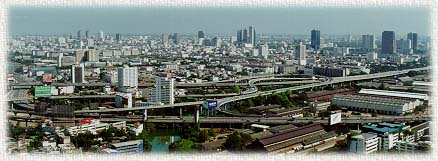 Not that its charms are immediately apparent. The sights that greet the first-time visitor are hardly likely to enchant him. Ribbons of concrete plunge
like daggers through the city's heart, tall buildings dwarf the Buddhist stupas, the sounds of a gentle people are
lost beneath the road of traffic. On first
encounter, it seems to be a city strangling in the throes of development. Except for a few sections, it looks very much like any other modern city.
Plucked down in a busy thoroughfare hemmed by tall buildings, one is hard put to know where he
is, only the curly-que lettering on the signs tells him
he isn't in Los Angeles or some other Western metropolis.
Not that its charms are immediately apparent. The sights that greet the first-time visitor are hardly likely to enchant him. Ribbons of concrete plunge
like daggers through the city's heart, tall buildings dwarf the Buddhist stupas, the sounds of a gentle people are
lost beneath the road of traffic. On first
encounter, it seems to be a city strangling in the throes of development. Except for a few sections, it looks very much like any other modern city.
Plucked down in a busy thoroughfare hemmed by tall buildings, one is hard put to know where he
is, only the curly-que lettering on the signs tells him
he isn't in Los Angeles or some other Western metropolis.
Bangkok covers an area of 626.1 square miles (1,565.2 square km) and has a population of 5,468,915 souls
(1986 statistics). Located 14 degrees north of the equator, it lies on the same latitude as Madras, Khartoum, Guatemala City, Guam and
Manila, like
them, its climate ranges from tepid to torrid. The sun in its eternal peregrination is the single most important element shaping the
moods and modes of
its people and daily life.
If Thailand is shaped like an elephant's head, then Bangkok is the beasts gold tooth. It is figuratively and laterally the epicenter of the nation. With a
population 50 times greater than the country's second largest city, it dominates all political, commercial, religious
and social activity in Thailand. Few
capital cities enjoy such primacy.
The seasons run from hot (March-June), to monsoon (July-November) to blissfully cool (December-February). The air is
perpetually humid but its
hothouse climate makes possible its lush plant life and the flowers that perfume the night air. Its warmth makes pleasant an evening in a garden
restaurant, suffuses the golden temples with glowing beauty and permeates the sunny dispositions of its people.
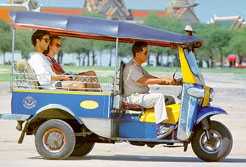 What is it about Bangkok that fascinates visitors? Its color, its chaos, its contrasts. It is the highs of temple architecture and graceful
dances, the lows
of the rawest forms of nightlife. It is the fabulous variety of food and the appealing differences between a rowdy city and gentle people.
Visitors to this city enjoy the TUK TUK ride.
What is it about Bangkok that fascinates visitors? Its color, its chaos, its contrasts. It is the highs of temple architecture and graceful
dances, the lows
of the rawest forms of nightlife. It is the fabulous variety of food and the appealing differences between a rowdy city and gentle people.
Visitors to this city enjoy the TUK TUK ride.
Bangkok explodes around you, challenging each of your senses, involving you in a way that few cities can. You are never at a lost for things to do in it.
It is a hedonists delight that can be explored on a number of levels, from the exalted to the mundane. It is a city of rich and poor people, of fragrances,
flowers and the fetid stench of stagnant canals. It is the pleasure of an afternoon by
the pool and the discomfort of the searing heat that burns the air and
bakes the pavements.
In short, it is an experience you cannot ignore. And, as you discover long after you have returned home, the feeling pervades your very being, its heart
becoming your heart.
Copyright © 2000 - 2002 HelloSiam.com All rights reserved.